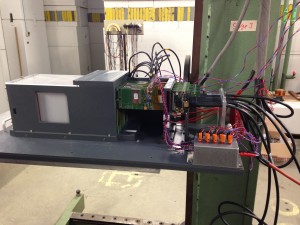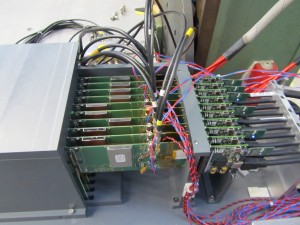
Complete setup of the SiW-ecal test in the test beam. The small silver box makes sure that the power pulsing works.
Particle detectors are expected to detect a lot of signal and very little background noise so that scientists can see what went on in their detector without being distracted by irrelevant signals. The technological prototype of the silicon-tungsten (SiW) electromagnetic calorimeter passed its first test in summer 2012 with flying colours with a signal to noise ratio that was between 14 and 20 to one (way better than the required ten to one). But that was then. Now, the task was to test the same prototype, but under different conditions: in a different powering mode, in a magnet, with beam.
The new powering scheme saves both space (no major cooling mechanisms are needed because very little heat is generated by the electronics) and power (thus money) by powering the components down between beam cycles. “Right now it’s more of an engineering challenge than a physics challenge,” says Roman Poeschl fom LAL in France. “Indeed it’s a completely new technique,” says engineer Remi Cornat of the French Laboratoire Leprince-Ringuet (LLR). “By trying it out in the DESY test beam we wanted to find out how feasible the system is.” They did two separate tests: running the prototype with power pulsing in a 2-Tesla magnet, and in the test beam from the DESY accelerator, but without a magnetic field. First results of the tests were presented at the CALICE Meeting at the University of Hamburg in March 2013.

Close-up of the technological protoype that was successfully tested with power pulsing in a magnetic field as well as with beam.
In the test, physics signals were well distinguished from detector noise in particular in power-pulsed detector layers. The exact signal-over-noise ratio needs to be evaluated, but the team is very happy with the first results of operation in power-pulse mode. “There seems to be no extra signal from the power supply, which means that the signal is just as clean as in continuous mode,” says Cornat. However, the team also learned more about the limits of their system. There was some cross-talk, issues with grounding and other prototype-stage flaws that help improve the system in the next step. “We know the limitations of our front-end electronics much better,” reports the engineer, and Pöschl concludes: “We have proof of the principle for our detector technology.”
The next step is a refined version of the detector, with more channels, more chips, more front-end boards that will grow to more than three times as many layers as it is now and a total length of two metres. Then there’s more testing to check the reliability and predictability of the new system. The final calorimeter would have about 100 000 front-end boards, 10 000 detector layers and consist of 1000 modules – a scale that can only be produced by industry. The team has already started discussions with the Japanese company Hamamatsu to see how labs and industry could produce the final detector.
VIDEO:
A short video showing the effect of the magnetic field on the cable that feeds the detector cards when a pulse of current passes. (Needless to say that the cards do not move)

Recent Comments